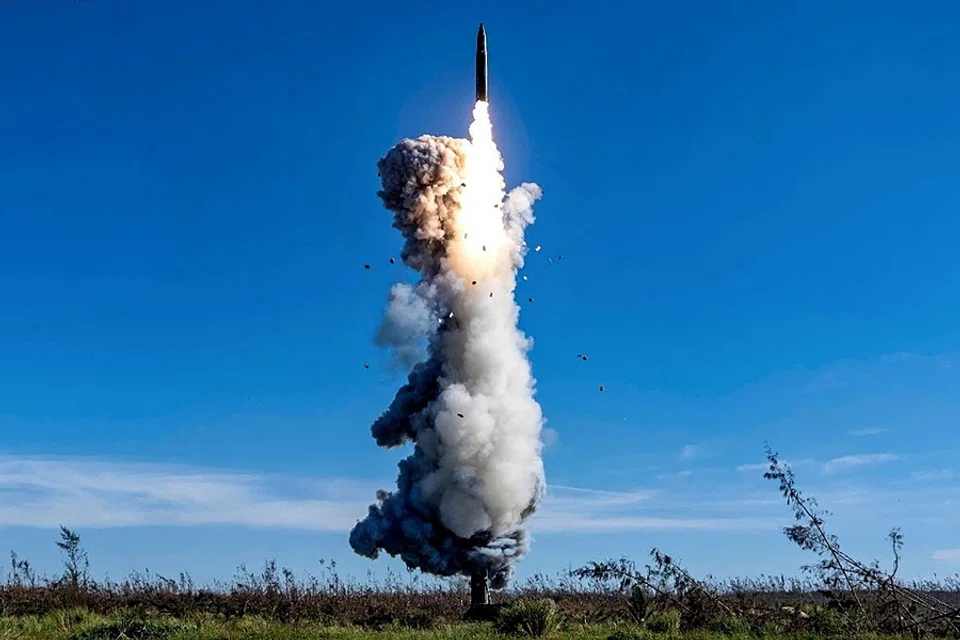China’s ICBM launch: A new era of military posturing?
Lianhe Zaobao associate editor Han Yong Hong notes that China’s recent test launch of an intercontinental ballistic missile across the Pacific could signal a new phase in its maritime and geopolitical strategy.

On the morning of 25 September, the 12th anniversary of the commissioning of China’s first aircraft carrier Liaoning, the People’s Liberation Army (PLA) launched an intercontinental ballistic missile (ICBM) into the Pacific, as though it was a “birthday present”.
Many observers believe that the missile launched was the Dongfeng-41 (DF-41), often referred to as a “doomsday device” due to its global strike capability. This successful launch underscores China’s nuclear strategic strike capabilities. While China celebrates this success, the international society is paying close attention.
China’s launch after 44 years
China’s defence ministry announced that the test was a routine military training that was “not directed against any country or target”. However, the trajectory of the missile towards the Pacific spells out China’s intent of deterring the US. The ongoing China-US competition as well as the US’s deployment of the “Typhon” midrange ground-based missile in Northern Luzon in the Philippines this year were all factors leading to the launch.
Such a quick reporting pace is a show of transparency, but even more so of China’s deterrence strength and confidence, as well as indirectly establishing norms for similar activities in the future.
But the context of this launch likely extends beyond one or two isolated events; it signifies the start of China’s long-term strategic initiative. The PLA deliberately chose the anniversary of the Liaoning’s official commissioning to showcase this significant move, demonstrating the “muscle” it has built over the past 12 years as it prepares for blue-water operations. This is also a landmark or an “announcement” of a new phase.
The launch was conducted at 8.44am on 25 September, and China’s defence ministry made an announcement at 10.03am, with high resolution pictures of the launch issued within 24 hours. Such a quick reporting pace is a show of transparency, but even more so of China’s deterrence strength and confidence, as well as indirectly establishing norms for similar activities in the future.

The DF-41, which was operationally deployed in 2017 and unveiled in 2019 during China’s National Day military parade, is China’s latest ICBM model in service. It can carry up to ten independently targeted warheads and alter its course to adjust to its target at any time. The “doomsday device” has a range of 12,000 km to 15,000 km, and if launched from eastern China, it can reach the US mainland in 30 minutes and is able to hit any target in the US.
For the US, Russia, the UK and France who are permanent members of the UN Security Council, launching an ICBM is not uncommon. China has been relatively restrained in this aspect as it has been 44 years since it last launched an ICBM.
Hence, in view of the recent clear improvement of China-US military relations — with a video teleconference between the commander of the PLA Southern Theater Command General Wu Yanan and commander of the US Indo-Pacific Command Admiral Samuel Paparo this month, along with a meeting in Hawaii — what message is China trying to send and what was its intent in this show of deterrence against the US?
This question has to be considered from a military, political and strategic perspective.
Another unspoken significance of China’s ICBM launch is to demonstrate that the previously scandal-plagued Rocket Force has revitalised itself and that its combat capability has not been compromised.
Developing global strategic nuclear strike capability on par with US
From a military perspective, as China steps up its show of military influence to the world, the testing and verification of the reliability of long-range weapons and the collection of relevant reference data is a necessary move. Chinese state media Xinhua revealed the PLA’s goal of military training, claiming that the launch of this ICBM carried a “dummy warhead” that “effectively tested the performance of weapons and equipment and the training level of the troops, and achieved the expected goal”.
Another unspoken significance of China’s ICBM launch is to demonstrate that the previously scandal-plagued Rocket Force has revitalised itself and that its combat capability has not been compromised.

Based on rough estimates, since last year, at least eight high-ranking officials of the Rocket Force have been dismissed, including Wei Fenghe, Zhou Yaning and Li Yuchao, the first three commanders of the Rocket Force. Sun Jinming, former chief of staff of the Rocket Force, has also been expelled from the Chinese Communist Party.
Such a group corruption case undoubtedly undermines the credibility of the military and its leadership. US media has also cited intelligence reports stating that some of the PLA’s missiles have been filled with water and that missile silos are unable to operate effectively.
The country believes that only when its military strength is on par with that of the US and the US loses its overwhelming military advantage will the US and the Western world accept its rise and abandon their strategy of containment.
Against this backdrop, the successful launch has significantly boosted the prestige of the Rocket Force and is also tantamount to dispelling rumours of “missiles filled with water”, which is of political significance both at home and abroad. Given China’s economic predicament, the PLA’s show of military might will also boost public morale.
More importantly, as the international situation becomes increasingly complex and China’s military strength continues to grow, the country may develop a global strategic nuclear strike capability, which would become a “standard feature” for a rising power.
China has continually strengthened its military capabilities over the years not only to safeguard its territorial interests, but also to gain leverage and confidence in direct competition with the US. The country believes that only when its military strength is on par with that of the US and the US loses its overwhelming military advantage will the US and the Western world accept its rise and abandon their strategy of containment.
Following this logic, China may adamantly and routinely showcase its strategic deterrent capabilities in the future, forcing other countries that have reservations and doubts to “get used to it”.
Avoiding war but embroiled in tension
Based on its current actions, China still hopes to rise and showcase its military deterrence peacefully. However, whether it can ultimately ensure peace depends on many factors, and the risk of conflict should not be underestimated. As it is, an international arms race is already underway, and frequent friction and military activities among countries of all sizes have also been escalating tensions in the Asia-Pacific region.
The longstanding mistrust and even hostility between China and the US and Japan, as well as between both sides of the Taiwan Strait, also further increases the risk of conflicts spiralling out of control.

In the case of China’s ICBM launch, the US and France confirmed that they had received advanced notification from China, with the Pentagon affirming it as a step “in the right direction” that “further reduces the risks of any misperception and miscalculation”.
Meanwhile, Australia and New Zealand expressed concern and scepticism, while Japan criticised China for not providing advance notice, asserting that Chinese and Russian military incursions into Japanese airspace and territorial waters have created “a strong sense of crisis” in the country.
When faced with the options of war and peace, the Chinese people and generations of leaders have historically approached the matter with caution and a reluctance to engage in conflict. However, there is always a risk that China or other regional countries would externalise their internal conflicts. The longstanding mistrust and even hostility between China and the US and Japan, as well as between both sides of the Taiwan Strait, also further increases the risk of conflicts spiralling out of control.
When major powers possess large arsenals of nuclear weapons, the cost of war will inevitably be heftier, pushing all parties to proceed with caution. The changes brought about by the rise of a great power will require all sides to make calm and rational choices.
This article was first published in Lianhe Zaobao as “中国发射洲际弹道导弹的战略意图”.



![[Photos] Fact versus fiction: The portrayal of WWII anti-Japanese martyrs in Taiwan](https://cassette.sphdigital.com.sg/image/thinkchina/3494f8bd481870f7c65b881fd21a3fd733f573f23232376e39c532a2c7593cbc)

